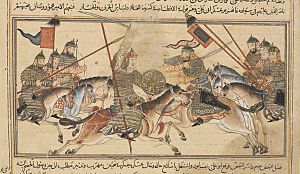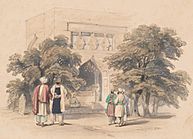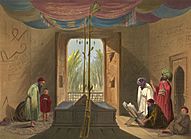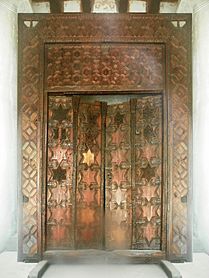Mahmud of Ghazni facts for kids
Quick facts for kids
|
|||||
|---|---|---|---|---|---|
|
|||||
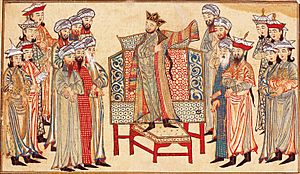
Mahmud of Ghazni (center) receives a robe from Caliph Al-Qadir; painting by Rashid-al-Din Hamadani
|
|||||
| Sultan of the Ghaznavid Empire | |||||
| Reign |
|
||||
| Predecessor | Ismail of Ghazni | ||||
| Successor | Muhammad of Ghazni | ||||
| Born | 2 November 971 Ghazni, Zabulistan, Samanid Empire (present-day Afghanistan) |
||||
| Died | 30 April 1030 (aged 58) Ghazni, Zabulistan, Ghaznavid Empire (present-day Afghanistan) |
||||
| Burial | Mosque and Tomb of Sultan Mahmud Ghaznavi, Ghazni Province, Afghanistan | ||||
| Issue |
|
||||
|
|||||
| Persian | یمینالدوله ابوالقاسم محمود بن سبکتگین | ||||
| Dynasty | House of Ghaznavid | ||||
| Father | Sabuktigin | ||||
| Religion | Sunni Islam (Hanafi) | ||||
| Military career | |||||
| Years of service | c. 998 – 1030 | ||||
| Awards | Robe of honour from Caliph Al-Qadir in 1000 CE. | ||||
Mahmud of Ghazni (born November 2, 971 – died April 30, 1030) was a powerful ruler who founded the Ghaznavid Empire. He ruled from 998 to 1030. By the time he died, his empire was huge. It stretched from parts of Iran to the Punjab region in India, and also included areas like Khwarazm and Makran.
Mahmud was very influenced by Persian culture. He kept many of the government and cultural traditions of the Samanids, who ruled before him. He also helped create a Persian-style state in the Punjab, especially around the city of Lahore, which he conquered. His capital city, Ghazni, became a major center for culture, trade, and learning in the Islamic world. It was almost as important as the famous city of Baghdad. Many important thinkers and artists, like al-Biruni and Ferdowsi, came to Ghazni.
Mahmud became ruler at age 27 after his father died. He had a short war with his brother Ismail to gain the throne. Mahmud was the first ruler to use the title Sultan, which means "authority." This showed how powerful he was, while still connecting him to the Abbasid Caliphs. During his rule, he led many campaigns into India. He took wealth from rich cities and temple towns, like Mathura and Somnath. He used this wealth to build up his capital city, Ghazni.
Contents
Early Life and Family
Mahmud was born in Ghazni, a town in the region of Zabulistan (now in Afghanistan), on November 2, 971. His father, Sabuktigin, was a Turkic military leader. Sabuktigin started the Ghaznavid dynasty in Ghazni in 977. At first, he ruled under the Samanids. Mahmud's mother was a Tajik woman from a wealthy family in Zabulistan. Because of this, some people called him Mahmud-i Zavuli (Mahmud from Zabulistan). We don't know much about Mahmud's early life. We do know he went to school with Ahmad Maymandi, who was like a foster brother to him.
Mahmud married a woman named Kausari Jahan. They had twin sons, Mohammad and Ma'sud. Both of them became rulers after Mahmud. His grandson, Maw'dud Ghaznavi, also ruled the empire later. Mahmud's sister, Sitr-e-Mu'alla, married Dawood bin Ataullah Alavi. Their son was Ghazi Saiyyad Salar Masud.
Mahmud also had a close companion, a Georgian slave named Malik Ayaz. Many poems and stories have been written about their friendship.
Rise to Power
In 994, Mahmud helped his father, Sabuktigin, capture Khorasan. They did this to help the Samanid Emir, Nuh II, against a rebel named Fa'iq. During this time, the Samanid Empire was very unstable. Different groups fought for control, including Abu'l-Qasim Simjuri, Fa'iq, Abu Ali, General Bekhtuzin, and the nearby Buyids and Kara-Khanid Khanate.
Sabuktigin died in 997. He chose his son Ismail to be the next ruler of the Ghaznavid dynasty. It's not clear why he chose Ismail over Mahmud, who was older and more experienced. Maybe it was because Ismail's mother was the daughter of Sabuktigin's old master. Mahmud soon rebelled. With help from his brother, Abu'l-Muzaffar, he defeated Ismail in 998 at the Battle of Ghazni. This gave Mahmud control of the Ghaznavid kingdom.
In 998, Mahmud went to Balkh and showed respect to Amir Abu'l-Harith Mansur b. Nur II. He then chose Abu'l-Hasan Isfaraini as his chief advisor, or vizier. After that, he moved west from Ghazni to take the Kandahar region. He then took Bost (Lashkar Gah), which he turned into a military city.
Mahmud's Reign and Campaigns
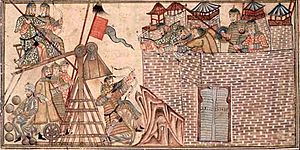
Mahmud began many campaigns into North India. On November 28, 1001, his army fought and defeated the army of Raja Jayapala of the Kabul Shahis at the Battle of Peshawar. In 1002, Mahmud invaded Sistan and removed Khalaf ibn Ahmad from power, ending the Saffarid dynasty. After this, he decided to focus on the rich lands of the Punjab region to the southeast.
Mahmud's first campaign to the south was against an Ismaili state in Multan. He also fought against the Fatimids. Jayapala tried to get revenge for an earlier defeat by Mahmud's father. Jayapala's son, Anandapala, continued the fight. He gathered a strong group of armies, but they were defeated. This happened when Anandapala's elephant turned back from the battle at a key moment. This gave Mahmud the advantage again at Lahore in 1008. Mahmud then gained control of the Shahi lands of Udbandpura.
Campaigns in India
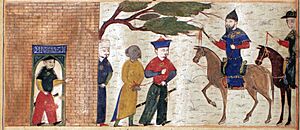
After defeating the Indian armies, Mahmud started regular expeditions against them. He left the conquered kingdoms under the rule of local leaders. He only added the Punjab region to his empire. He also promised to raid and take wealth from northwestern India every year.
In 1001, Mahmud first invaded parts of modern-day Pakistan and then India. He defeated and captured the Hindu Shahi ruler Jayapala, but later released him. Jayapala's son, Anandapala, took over. In 1005, Mahmud invaded Bhatia. In 1006, he invaded Multan, and Anandapala's army attacked him. The next year, Mahmud defeated Sukhapala, the ruler of Bathinda. In 1008–1009, Mahmud defeated the Hindu Shahis again in the Battle of Chach. By 1013, the Shahi kingdom was overthrown during Mahmud's eighth expedition.
In 1014, Mahmud led a campaign to Thanesar. The next year, he attacked Kashmir but was not successful. The ruler of Kashmir, Sangramaraja, had helped the Hindu Shahis against Mahmud. Mahmud wanted revenge. He tried to enter Kashmir through a mountain pass but was stopped by the strong fort of Loharkot. He besieged the fort for a month but then gave up and retreated, losing many soldiers. In 1021, Mahmud tried to invade Kashmir again but was again stopped by Loharkot fort. After these two failed attempts, he did not try to invade Kashmir again.
In 1018, Mahmud attacked Mathura. He defeated a group of rulers there and killed a ruler named Chandrapala. The city of Mathura was heavily damaged. According to some historical accounts, Mahmud destroyed a "great and magnificent temple" in Mathura. The city was said to be the richest in India. Its idols were destroyed, and gold and silver were taken. The city was also burned down.
In 1021, Mahmud helped the Kannauj king against Chandela Ganda, who was defeated. That same year, Shahi Trilochanapala was killed, and his son Bhimapala took over. Lahore (modern Pakistan) was added to Mahmud's empire. Mahmud besieged Gwalior in 1023 and received tribute. Mahmud attacked Somnath in 1025, and its ruler Bhima I fled. The next year, he captured Somnath. He also attacked the Jats of Jud and defeated them.
After the Somnath raid, Mahmud chose a dangerous route through the Sindh desert to avoid strong armies led by Bhoja. Many of his soldiers and animals died in the desert due to lack of food and water. In 1026, Jats caused heavy losses to Mahmud's army as it returned from Somnath. Later, in 1027, Mahmud got revenge on the Jats. He destroyed their fleet in the Indus River. Even though the Jats had more boats, Mahmud used his 1400 boats, each with about 20 archers and special burning projectiles, to destroy the Jats' fleet.
Mahmud conquered Indian kingdoms like Nagarkot, Thanesar, Kannauj, and Gwalior. He left them under the rule of local Hindu, Jain, and Buddhist kings. He also made alliances and included local people in his armies. Since Mahmud did not keep a permanent presence in northwestern India, he sometimes destroyed Hindu temples and monuments. This was done to prevent any attacks on his empire. Places like Nagarkot, Thanesar, Mathura, Kannauj, Kalinjar (1023), and Somnath were either taken or raided.
Later Challenges
The last four years of Mahmud's life involved dealing with new groups of Oghuz and Seljuk Turks from Central Asia. At first, Mahmud pushed them back. But the Seljuks, led by Togrül and Çagrı, later captured Merv and Nishapur (1028–1029). They continued to raid and take land from Mahmud's successors in Khorasan and Balkh. They even attacked Ghazni in 1037. In 1040, at the Battle of Dandanaqan, they completely defeated Mahmud's son, Mas'ud I. This made Mas'ud lose most of his western lands to the Seljuks.
Sultan Mahmud died on April 30, 1030. His tomb is in Ghazni, Afghanistan.
Campaign Timeline
As Emir
- 994: Becomes Governor of Khorasan and gets the title Saif ad-Dawla.
- 995: Samanid rebels expel Mahmud from Nishapur. Mahmud and Sabuktigin defeat them at Tus.
- 997: Kara-Khanid Khanate.

As Sultan
- 999: Takes Khorasan, Balkh, Herat, and Merv from the Samanids.
- 1000: Takes Sistan from the Saffarid dynasty.
- 1001: Gandhara: Sultan Mahmud defeats Raja Jayapala in the Battle of Peshawar.
- 1002: Seistan: Imprisons Khuluf.
- 1004: Bhatia (Bhera) is taken after it fails to pay tribute.
- 1005-6: Multan: Fateh Daud, the Ismaili ruler, revolts. Mahmud defeats him and attacks the Ismailis of Multan.
- 1005: Defends Balkh and Khorasan against Nasr I of the Kara-Khanid Khanate.
- 1005: Sewakpal rebels and is defeated.
- 1008: Mahmud defeats the Hindu Shahis in the Battle of Chach and captures the Shahi treasury at Kangra, Himachal Pradesh.
- 1010: Ghor; against Amir Suri.
- 1010: Multan revolts. Abul Fatah Dawood is imprisoned.
- 1012-1013: Raids Thanesar.
- 1012: Invades Gharchistan and removes its ruler.
- 1012: Gets the rest of Khorasan from the Abbasid Caliph.
- 1013: Bulnat: Defeats Trilochanpala.
- 1014: Kafiristan is attacked.
- 1015: Mahmud's army raids Lahore. His trip to Kashmir fails due to bad weather.
- 1015: Khwarezm: Marries his sister to Abul Abbas Mamun. Later, he puts a new ruler in place.
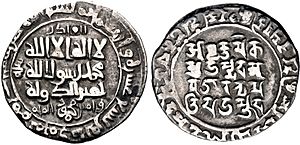
- 1017: Takes Kannauj, Meerut, and Mathura. Kannauj and Meerut surrender without a fight.
- 1018-1020: Raids the town of Mathura.
- 1021: Makes Ayaz king of Lahore.
- 1021: Marches to help Kannauj. Takes Lahore on his way back. First Muslim governors are appointed east of the Indus River.
- 1023: Lahore. Forces Kalinjar and Gwalior to pay tribute. Punjab is officially added to Ghazni.
- 1024: Ajmer, Nehrwala, Kathiawar: This is his last major campaign. He raids the famous Somnath. The temple and fort are attacked, and many defenders are killed.
- 1025: Somnath: Mahmud raids the temple. He is said to have broken the temple's golden Lingam. The pieces are taken to Ghazni and used in the steps of the city's new mosque. He puts a new king on the throne in Gujarat.
- 1025: Marches against the Jats of the Jood mountains who attacked his army returning from Somnath.
- 1027: Takes Rey, Isfahan, Hamadan from the Buyids Dynasty.
- 1027: Destroys the Jats' fleet in the Indus river.
- 1028, 1029: Loses Merv and Nishapur to the Seljuq dynasty.
Views on Religion and War

Under Mahmud's rule, the region broke away from the Samanid influence. While he recognized the Abbasids as caliphs, he was also given the title Sultan. This showed his independence.
After being recognized by the Abbasid caliphate in 999, Mahmud pledged to lead campaigns into India every year. In 1005, he led campaigns where the Ismailis of Multan were attacked.
Some modern historians say that his actions towards Hindus were mainly for wealth, not just religious reasons. Mahmud used the wealth he gained to pay for his armies. These armies included soldiers from India, who were likely Hindus. They had their own commander called sipahsalar-i-Hinduwan and lived in their own part of Ghazna, practicing their own religion. Indian soldiers remained loyal to Mahmud. They were even used against a Turkic rebel, led by a Hindu named Tilak.
Mahmud was also known as "Mahmud but-shikan" (Mahmud the breaker of idols).
Legacy
By the end of his rule, the Ghaznavid Empire was very large. It stretched from Ray in the west to Samarkand in the northeast. It also went from the Caspian Sea to the Yamuna River. Even though his armies went across India, only parts of the Punjab region and Sindh (in modern-day Pakistan) became permanently part of his empire. Areas like Kashmir, the Doab, Rajasthan, and Gujarat stayed under the control of local Hindu rulers.
A huge amount of wealth was brought back to Ghazni. Historians at the time described how magnificent the capital city was. They also wrote about Mahmud's generous support for literature. He made Ghazni a leading city in Central Asia. He supported scholars, built colleges, created gardens, and constructed mosques, palaces, and inns for travelers. Mahmud even brought entire libraries from other cities to Ghazni. He also asked the Khwarizmshah court to send its learned people to Ghazni.
Mahmud supported the famous poet Ferdowsi. Ferdowsi worked for 27 years on his epic poem, the Shahnameh. He then went to Ghazni to present it to Mahmud. There are stories that Mahmud did not show much interest in Ferdowsi's work. Some historians say Mahmud promised Ferdowsi a gold coin for every line of the Shahnameh. But he later gave him silver coins instead, which were worth much less. Mahmud's campaign across the Gangetic plains in 1017 inspired Al-Biruni to write his book Tarikh Al-Hind. This book helped people understand Indians and their beliefs. During Mahmud's rule, universities were created to study subjects like math, religion, humanities, and medicine.
Sultan Mahmud died in Ghazni on April 30, 1030, at age 58. He had caught malaria during his last invasion. This led to tuberculosis, which caused his death.
His successors ruled the Ghaznavid Empire for 157 years. The growing Seljuk empire took over most of the Ghaznavid western lands. The Ghorids captured Ghazni in 1150. Later, Mu'izz al-Din captured the last Ghaznavid stronghold at Lahore in 1187.
Even though Mahmud was a great military leader, he didn't fully unite his conquered lands with a gentle hand. He also wasn't a genius at running a government. He couldn't build lasting systems in his state during his rule.
The military of Pakistan has named its short-range ballistic missile the Ghaznavi Missile in honor of Mahmud of Ghazni. Also, the Pakistan Military Academy, where army officers are trained, has a company named Ghaznavi Company to honor him.
Personality
Sultan Mahmud saw himself as "the Shadow of God on Earth." This meant he believed his will was law and he had absolute power. He paid close attention to details in almost everything. He personally watched over the work of every part of his government.
Mahmud chose all his ministers himself. He usually didn't ask his chief advisor (wazir) for advice. He was often suspicious of his ministers, especially his wazir. He is believed to have said, "wazirs are the enemies of kings..." Sultan Mahmud had many spies (called mushrifs) across his empire. A special department in his government managed these spies.
Mahmud supported literature, especially poetry. He was often seen with talented poets in his palace or royal garden. He was usually generous to them, paying well for their works based on their talent.
Images for kids
-
Ruins of the Somnath temple in the 19th century. Photograph by Henry Cousens
-
Mahmud of Ghazni raided India as far as Somnath, Mathura and Kannauj in Gurjara-Pratihara territory.
See also
 In Spanish: Mahmud de Gazni para niños
In Spanish: Mahmud de Gazni para niños


